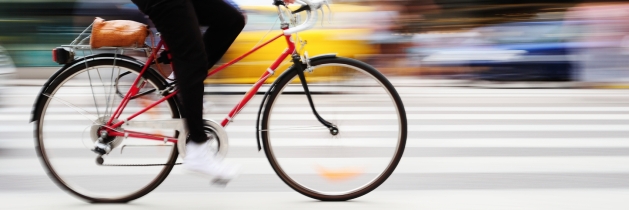Blogs

Creating a Multicultural Marketing Program
This past weekend I had a great opportunity to spend time at NYU in a course through their School of Continuing and Professional Studies. I gathered with a small group of other professionals talking about ethnic marketing and ways to reach multicultural communities. Such interesting discussions and data--and truly invigorating to be with other professionals eager to make those vital connections to important communities in the U.S. Why is multicultural marketing something to pay attention to? Ethnic markets are gaining in population and buying power. They are the fastest growing segment in the U.S.! The majority are in largest cities, and growing in small cities too. While we may all think we already know this, it's great to get back to basics and see the data. The Hispanic, Asian, and African American markets combined already comprise 50% or more of top 10 urban areas, with annual purchasing power of $2 trillion. This population is 10 million larger than baby boomers demographic group. And it's so important to be mindful of the diversity within diversity. For example, 15% of the U.S. population is Hispanic. Of that market, 63% are Mexican, while 35 other cultures contribute to the balance--such as Puerto Rican, Spanish, Venezuelan, Columbian, Panamanian, Guatemalan, and more. The same diversity is, of course, true with Asian and Arab cultures. Guess what, it's even true with "Americans." When communicating with these groups, we can't assume a lack of English proficiency. It's important to know the appropriate times to use in-language marketing tactics. But when your communication is in-language it tells the community you care about them, you understand them, and they are important. I'd love to talk more and share my insights into how language translation is a vital component in the process of creating a multicultural marketing program with cultural relevance. Call or email us today and let's continue the discussion!

Take Action: Support Translated Prescription Drug Labels
Avantpage joined the California Pan-Ethnic Health Network (CPEHN) in taking action to support translation of prescription drug labels--we encourage you to take action also by May 13, 2010. CPEHN writes, "Despite public outcry, the Board of Pharmacy continues to advance weak regulations that do not ensure the readability of prescription drug labels. These next two weeks are our final opportunity to write the Board and demand strong patient-centered prescription labels-- labels that are in a 12-point font size and translated in other languages." Join us in sending your comments to the California State Board of Pharmacy asking for culturally appropriate labels. Comments are due by May 13! CPEHN recommends telling the Board: Please direct comments to: Carolyn Klein Manager, Legislation and Regulations California State Board of Pharmacy 1625 N. Market Blvd., N219 Sacramento, CA 95834 Fax: (916) 574-8618 For information or to let us know you took action, email Marty Martinez. Additional information is available at the Board of Pharmacy website.

Use of Personal Health Records Growing; More Translation Will Be Needed
This week I read an engaging and informative survey report released by the California HealthCare Foundation (CHCF) detailing Americans' usage of personal health records, or PHRs. What's a PHR? According to the American Health Information Management Association (AHIMA), a PHR is "a tool that you can use to collect, track and share past and current information about your health or the health of someone in your care." A personal health record is different from a medical record because it is the patient's responsibility to compile and maintain a PHR. The survey indicates one in 14 Americans has used a personal health record, double the number of users from a year earlier. This number is almost certain to continue growing as the adoption of electronic health records, or EHRs, becomes more widespread. The American Recovery and Reinvestment Act of 2009 included up to $29 billion to support providers' adoption and meaningful use of such records. Highlights of the survey showed that more than half of PHR users learned something about their health as a result of their PHR and a third of users used the PHR to take action to improve their condition. In addition, low-income PHR users (60%) tended to feel more connected to their doctor as a result of using a PHR. While private companies offer PHR solutions, over half of respondents to the survey said they felt most comfortable using a PHR provided by their doctor or insurer. PHR Translation Is Urgently Needed... Since the results of the study showed that low-income PHR users stand to benefit greatly from PHR use, and in many areas of the country, the limited-English and low-income demographics overlap, it makes sense that PHR providers should expand PHR offerings to other languages as soon as possible. People who primarily speak Spanish or another language should not be denied this service. If something as simple as maintaining a personal health record can help people feel more connected to providers and be more proactive about their health decisions, then everyone should get one! Do you have a PHR? Luis Miguel, CEO tel: 530.750.2040, ext. 1

A Behind-The-Scenes Look At Our Translation Process
Avantpage Translations recently released a special report called "Translation Technology 101: How It's Changing The Business and How We Use It". The new technologies used by companies such as Google have made computer, or machine, translation more accurate than ever. But just how reliable are these translations? Are translation companies going to start "cutting corners" by using machine translation software? How does machine translation work? As companies consider these questions related to translation technology and the way it may impact their business, Avantpage has created this report to help answer some of these questions. In Part II of the report, Avantpage discusses the ways that they use technology to make their "human" translation services more efficient on a daily basis-without sacrificing quality.

The Census: Where’s the ethnicity/national origin question?
That was our response upon receiving our census form in the mail. After all, the country of origin question goes a long way in determining what kind of language services an area needs to provide for local residents. Well, it’s sort of on the census. You see, under Question 9 about race, there are boxes for “white, black, American Indian, Asian Indian, Chinese, Filipino, Japanese, Korean, Vietnamese, Other Asian, Native Hawaiian, Guamanian/Chamorro, Samoan, Other Pacific Islander, or “Some Other Race.” So one can glean some information about national origin and languages spoken from this version of the census, but there are some notable categories missing here. Arab-Americans are often divided about how to fill out this item—most choose “white,” but feel oddly doing so. In the same way, this form doesn’t accurately count Russian-Americans or Americans of Polish heritage, since those groups also self-identify as “white.” Here’s the answer to the “missing ethnicity question,” straight from the Census Bureau: “The 2010 Census isn’t designed to capture data on a person’s ancestry. We capture that information on the American Community Survey (ACS), which is part of the official census but conducted throughout the decade on a rolling sample of about 2.5 percent of the population every year. In Census 2000 and earlier decades what is now the ACS was commonly called “the long form” of the census; the 2010 Census is the first to use a short form only.” Time will only tell whether the ACS provides us with an accurate accounting of the many ethnic and linguistic groups within America, and whether this experiment with a “short form” proves costly in the long run for historically underrepresented groups.

The ROI of Language Assistance: How It Pays to Communicate in Your Patients’ Language
Research shows that the per-patient costs of Language Assistance are low, while providing services in a culturally and linguistically appropriate (CLAS) manner leads to better patient outcomes and significantly lower costs to the system. With minorities providing most of the growth in California's population today and in the future, offering CLAS is a key factor in growing your patient base. Avantpage offers quality language access solutions at the government, insurer, provider, and individual level. We also have specific recommendations on how to start and implement a professional Language Assistance program. To learn more about how the cost benefits of language access, and the benefits to patients and community, contact Avantpage at 530-750-2040.

New Report: Translation Technology 101 (Part I)
Today Avantpage Translations released a special report called "Translation Technology 101: How It's Changing The Business and How We Use It". The new technologies used by companies such as Google have made computer, or machine, translation more accurate than ever. But just how reliable are these translations? Are translation companies going to start "cutting corners" by using machine translation software? How does machine translation work? Read Part I of our report here, as we discuss the evolution of translation technology, specifically machine translation. We also explore the benefits and drawbacks of using this technology, as well as potential applications.

10 Best Practices for Translation
Whether your company is in need of translation services for the first time or you have years of experience, it's always good to review best practices. These 10 tips can help your business navigate the process of obtaining, coordinating, and evaluating translation services. Because Avantpage realizes how important it is to get things right from the beginning. 1) Be an educated translation consumer. When it comes to selecting a Language Services Provider (LSP) you must get well-acquainted with their translation process and quality assurance procedures, as well as the costs. It goes without saying that the cheapest translation provider may not be the best one for your company, but a good provider will be able to find ways to save you money. 2) Do an internal-needs assessment. This involves asking some critical questions before you proceed. What languages are you dealing with? Is a particular linguistic group within your area not considered a "threshold" language according to some definitions, but you know the population is growing? Does it make economic sense to begin providing translation service in this area anyway? What types of vital documents will you need to have translated? What data formats are the documents in? 3) Allocate appropriate resources. Providers of medical plans may already realize this, but any large company that is serious about translation should have a Cultural & Linguistics department or coordinator. It's also essential to allocate an appropriate budget, since you will need to hire a certified LSP. 4) Plan the translation process. Work with your language service provider to determine your process, what steps will take place each time a document is translated and how your specific needs will be met. What regulations must you follow in regards to translation? 5) Make sure all translation is coordinated from the top down. This seems like common sense, but the head of the C&L department should work with the LSP to ensure consistency throughout all documents. Recurrent phrases that have to be rewritten to make sense in the target language should always be translated the same way... This leads to #6. 6) Create style guides and glossaries. Compiled manually, style guides and glossaries do not affect the cost or time of your translations. They increase the overall quality and consistency of your documents. A glossary contains important terms with their preferred translations, and the style guide lets translators know linguistic and stylistic preferences (such as the audience and tone of the document.) 7) Stay ahead of the game by standardizing vital documents and pre-translating non-standard vital documents. If you know the need will exist to have a particular form or other document translated, it only makes sense to get it done ahead of time. Vital documents include applications, consent forms and letters. Non-standard documents usually contain information specific to one person, such as a health care service authorization. 8) Design and write documents appropriately. What does this mean? You have to assume that your audience may only read at the elementary school level. Keep information written for the consumer as simple and clear as possible. This will also help you when it comes time to have documents translated. Documents that require certain wording for legal purposes can still be written in words everyone can understand-it may just take a little extra effort. 9) Design appropriate internal review processes. How will you know when a translation is finished? ASTM STD. F 2575‐06 is mainly used in the USA and will give you a good starting point to discuss the quality assurance process with your LSP. If your company works in Europe, you may need to use EN 15038 as a standard instead. 10) Be an active part of the translation process and community. To ensure that you get the greatest value out of your translation services, be an active part of the process. If you have one main LSP, consider having a backup available in case of emergencies. Work closely with them at all times. Join professional organizations that will help you stay on top of changes to the law. When you anticipate regulatory changes, it will be easier to comply. Finally, always look ahead to the future of translation in your industry. When you begin to think of translation as more than just compliance, but a tool to reach new markets, you'll see that quality translations aren't just necessary; they're part of an investment strategy that will eventually have a major payoff.

What is an Attestation?
Translation attestation is an important regulatory requirement for Federal Medicare and California Language Assistance programs (Executive Order 13166, California Code of Regulations sections 1300.67.8 and 1304.67.04, and California Insurance Code sections 82538.1 to 82538.8). An attestation is the equivalent to a notarized certification; it simply corroborates or authenticates the facts detailed. It's not a guarantee of quality. The actual translation must be performed according to agreed-upon processes and standards. To learn more about Avantpage's attestations and our policies, contact Laura Kujubu, VP of Operations, at 530-750-2040, x3.

How Does Avantpage Select Its Translators?
Ever wonder how we find and then screen our translators? Firstly, translators apply to Avantpage via our Careers page on our website or they can be referrals from translators who work with us already. But then what? Do we just read their resumes, and make them take a quick test? No! Avantpage translators perform sample tests, submit work samples, are interviewed, and present valid certification from a professional translation institution. And that's just our pre-qualification step. After that, translators are qualified, sign non-disclosure agreeements, are thoroughly monitored, and much, much more. To learn more about how we select our translators, contact Laura Kujubu, Sr. Director of Operations & Customer Relations, at 530-750-2040, x3. Laura will fill you in on our continuous training program on Avantpage project management tools, our quality control process, customer service guidelines, and why you can be sure that with our team of professional translators you're getting best-in-the-industry quality.

Interested in Doing Medical Interpreting Field Work in Haiti?
The International Medical Interpreters Association (IMIA) has been recruiting medical interpreters interested in doing field work in Haiti. The USNS Comfort is assisting Haitian victims since the disaster took place. The American Red Cross in Miami is organizing the placement in the USNS Comfort and has requested the assistance of the IMIA to recruit professional Haitian medical interpreters. Over 100 interpreters were deployed last month and there will be rotations of 34 interpreters each month.
Click here to find the recruitment criteria, guidelines and the deployment guidelines. Please read the document carefully.
The Red Cross will pay for travel to Miami and provide lodging and meals aboard the USNS Comfort as well as telephone cards. Term of field work is 30 days. If you are seriously interested and committed to volunteering for this specific field work at the USNS Comfort, please do the following:
Thanks!

New California Law Protects Limited-English Consumers In Real Estate Transactions
According to data from the United States Census of 2000, the top five languages other than English most widely spoken by Californians in their homes are Spanish, Chinese, Tagalog, Vietnamese, and Korean. Together, these languages are spoken by approximately 83 percent of all Californians who speak a language other than English in their homes, or more than 9.96 million people. When you consider that it can be difficult even for native English speakers to understand a complicated real estate contract, it's not hard to imagine that limited-English individuals are especially susceptible to fraudulent lending practices. California Assembly Bill 1160, passed in 2009 and in effect as of January 1, 2010, addresses this. If negotiations for a real estate transaction are conducted in Spanish, Chinese, Tagalog, Vietnamese, or Korean, the borrower must be given a written translation of the contract and/or the appropriate disclosures and forms. If there are any substantial revisions to the contract, then these revisions must be translated as well. Avantpage has released a special report called "New Standards For Contract Translation In California." The report discusses the full implications of the new law as well as strategies for lenders and brokers seeking compliance.